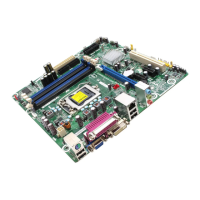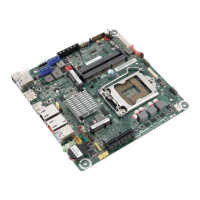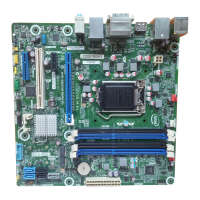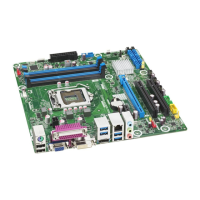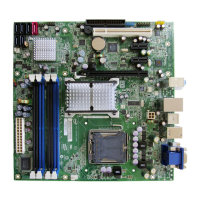Intel Desktop Board DQ67OW Technical Product Specification
20
1.9 SATA Interfaces
The board provides six SATA connectors through the PCH, which support one device
per connector:
• Two internal SATA 6 Gb/s ports (blue)
• Two internal SATA 3 Gb/s ports (black)
• Two internal eSATA 3 Gb/s ports for external connectivity (red)
The PCH provides independent SATA ports with a theoretical maximum transfer rate of
6 Gb/s for two ports and 3 Gb/s for four ports. A point-to-point interface is used for
host to device connections.
The underlying SATA functionality is transparent to the operating system. The SATA
controller can operate in both legacy and native modes. In legacy mode, standard IDE
I/O and IRQ resources are assigned (IRQ 14 and 15). In Native mode, standard PCI
Conventional bus resource steering is used. Native mode is the preferred mode for
configurations using the Windows* XP, Windows Vista*, and Windows 7* operating
systems.
For more information, see: http://www.serialata.org/
.
For information about Refer to
The location of the SATA connectors Figure 10, page 45
1.9.1.1 Serial ATA RAID
The board supports the Intel Rapid Storage Technology (Intel RST) which provides the
following RAID (Redundant Array of Independent Drives) levels:
• RAID 0 - data striping
• RAID 1 - data mirroring
• RAID 0+1 (or RAID 10) - data striping and mirroring
• RAID 5 - distributed parity
NOTE
In order to use supported RAID features, you must first enable RAID in the BIOS. Also,
during Microsoft Windows XP installation, you must press F6 to install the RAID
drivers. See your Microsoft Windows XP documentation for more information about
installing drivers during installation. Both Microsoft Windows Vista and Microsoft
Windows 7 include the necessary RAID drivers for both AHCI and RAID without the
need to install separate RAID drivers using the F6 switch in the operating system
installation process.

